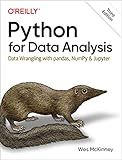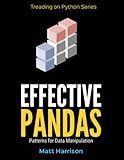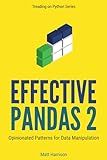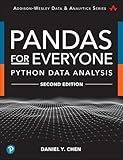Best Methods to Buy for Efficient Pandas DataFrame Management in December 2025

Python for Data Analysis: Data Wrangling with pandas, NumPy, and Jupyter



Effective Pandas: Patterns for Data Manipulation (Treading on Python)



Effective Pandas 2: Opinionated Patterns for Data Manipulation (Treading on Python)



Pandas for Everyone: Python Data Analysis (Addison-Wesley Data & Analytics Series)



Pandas for Everyone: Python Data Analysis (Addison-Wesley Data & Analytics Series)



Pandas in Action



Pandas Workout: 200 exercises to make you a stronger data analyst



Effective Visualization: Exploiting Matplotlib & Pandas (Treading on Python)



Pandas Cookbook: Practical recipes for scientific computing, time series, and exploratory data analysis using Python


To replace .append with .concat in pandas dataframe, you can use the pd.concat() function instead. This function allows you to concatenate two or more dataframes along a particular axis. Simply pass in the dataframes you want to concatenate as arguments to pd.concat() and specify the axis along which you want to concatenate them. This replaces the need for using the .append() method on individual dataframes.
How to replace .append with .concat in pandas dataframe?
To replace the .append method with the .concat method in a pandas DataFrame, you can use the pd.concat() function as follows:
- Create a new DataFrame that you want to concatenate with the original DataFrame.
- Use the pd.concat() function to concatenate the two DataFrames.
Here's an example code snippet to demonstrate how to replace .append with .concat in a pandas DataFrame:
import pandas as pd
Create the original DataFrame
df1 = pd.DataFrame({'A': [1, 2, 3], 'B': [4, 5, 6]})
Create a new DataFrame to concatenate
df2 = pd.DataFrame({'A': [7, 8, 9], 'B': [10, 11, 12]})
Replace .append with .concat
df = pd.concat([df1, df2], ignore_index=True)
print(df)
In the above code snippet, we first create two DataFrames df1 and df2. Then, we use the pd.concat() function to concatenate the two DataFrames along the rows with the ignore_index=True parameter to reset the index of the concatenated DataFrame.
By following these steps, you can replace the .append method with the .concat method in a pandas DataFrame.
How to concatenate dataframes with overlapping columns in pandas?
You can concatenate dataframes with overlapping columns in pandas by using the concat function. By default, the function will concatenate along axis 0 (rows) and will keep all columns, with overlapping columns having their values combined.
Here is an example of how you can concatenate two dataframes with overlapping columns:
import pandas as pd
Create two dataframes with overlapping columns
df1 = pd.DataFrame({'A': [1, 2, 3], 'B': [4, 5, 6]}) df2 = pd.DataFrame({'B': [7, 8, 9], 'C': [10, 11, 12]})
Concatenate the two dataframes
result = pd.concat([df1, df2])
print(result)
Output:
A B C
0 1.0 4 NaN 1 2.0 5 NaN 2 3.0 6 NaN 0 NaN 7 10.0 1 NaN 8 11.0 2 NaN 9 12.0
In the resulting concatenated dataframe, the overlapping column 'B' has its values combined, while the unique columns 'A' and 'C' from each dataframe are included in the final result.
How to speed up concatenation process with .concat function in pandas?
- Use the ignore_index=True parameter to ignore the existing indexes of the concatenated dataframes. This will speed up the concatenation process as pandas does not have to realign the indexes.
- Use the axis=1 parameter if you are concatenating dataframes along columns instead of rows. Concatenating along columns may be faster than along rows in certain cases.
- Avoid concatenating a large number of dataframes at once. Instead, concatenate a smaller number of dataframes multiple times to improve performance.
- Use the copy=False parameter if you are sure that the original dataframes do not need to be copied. This can save memory and improve performance.
- If possible, pre-allocate memory for the final concatenated dataframe by using the pd.concat() function with an empty list as an argument. This can reduce the overhead of reallocating memory dynamically during concatenation.
How to combine dataframes with different column names using .concat?
If you have two dataframes with different column names and you want to combine them using .concat(), you can do so by specifying the axis along which you want to concatenate the dataframes and indicating how you want to handle columns that do not match. Here is an example:
import pandas as pd
Creating two dataframes with different column names
df1 = pd.DataFrame({'A': [1, 2, 3], 'B': [4, 5, 6]})
df2 = pd.DataFrame({'C': [7, 8, 9], 'D': [10, 11, 12]})
Concatenating the dataframes along axis 1 (columns) and filling missing columns with NaN
result = pd.concat([df1, df2], axis=1) print(result)
In this code snippet, we use the pd.concat() function to combine df1 and df2 along axis 1, which will result in concatenating the dataframes by their columns. Since df1 and df2 have different column names, columns that do not match will be filled with NaN.
You can also customize the behavior of missing columns by passing additional arguments to the pd.concat() function, such as join='inner' to include only columns that are present in both dataframes or join='outer' to include all columns from both dataframes.
What is the purpose of using .concat in pandas dataframe?
The purpose of using .concat in pandas dataframe is to concatenate two or more dataframes along a particular axis (row or column). This allows you to combine data from different sources or perform operations on multiple dataframes at once. It does not modify the original dataframes, but instead creates a new dataframe with the concatenated data.
